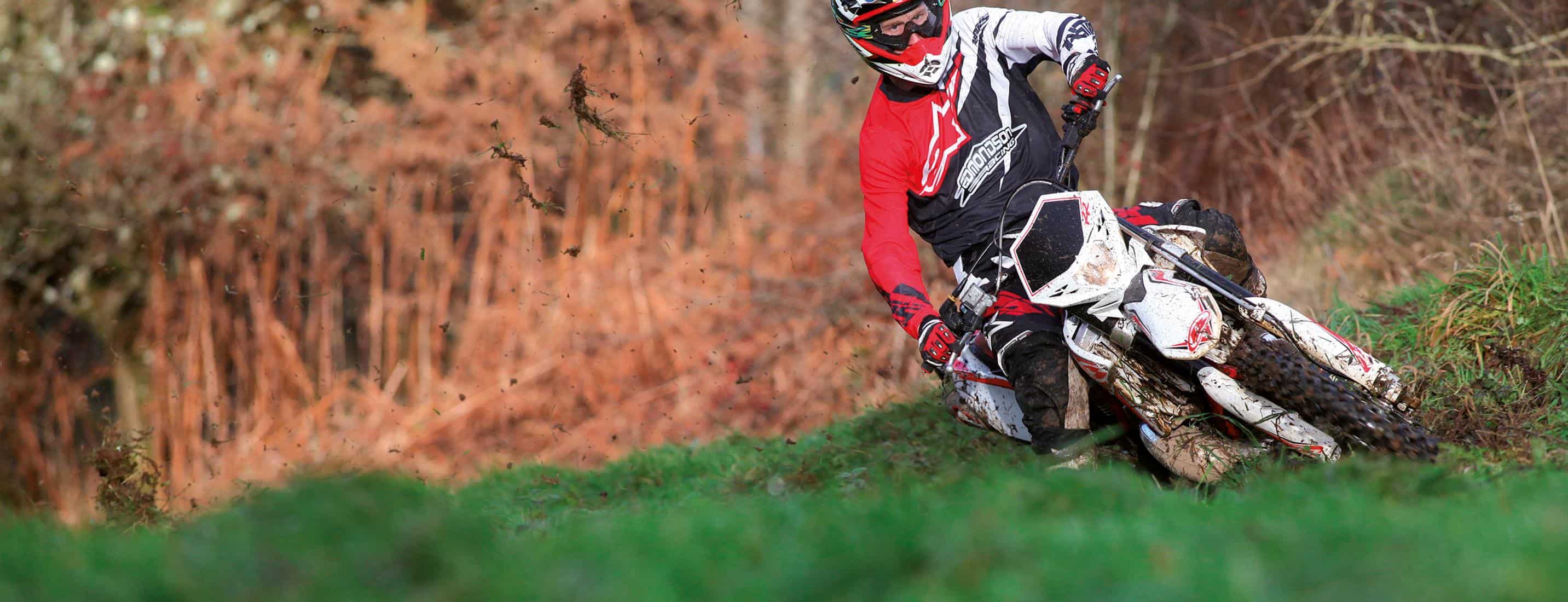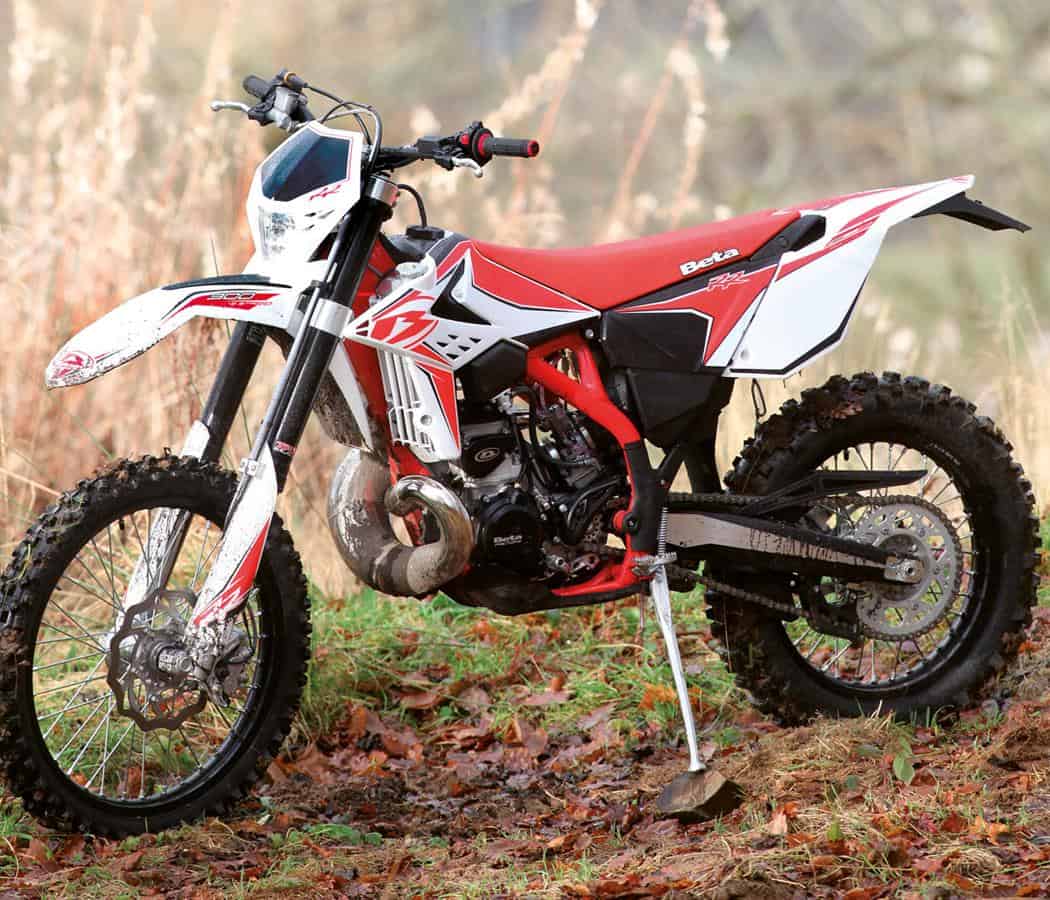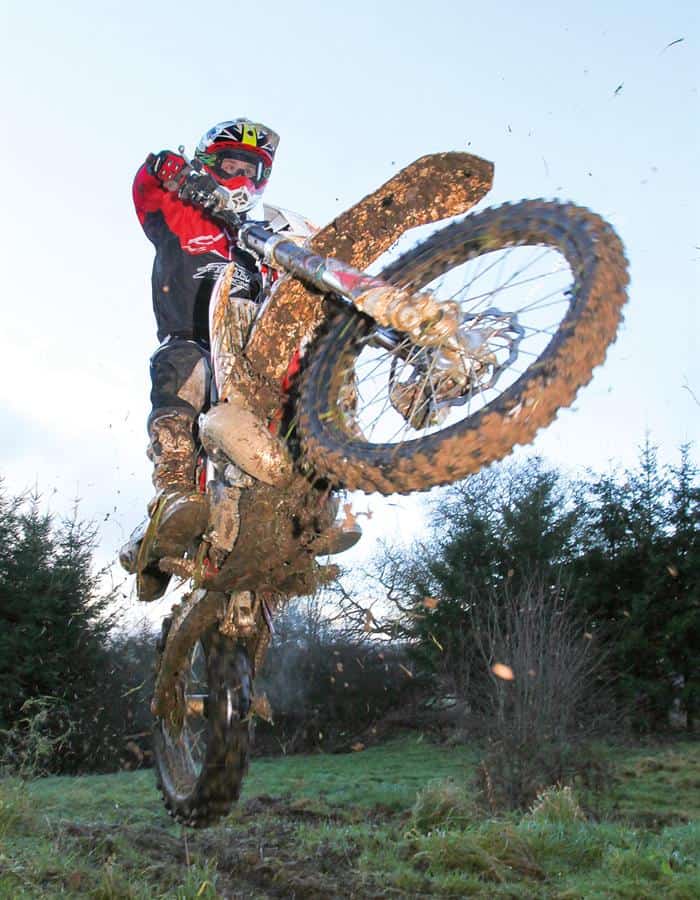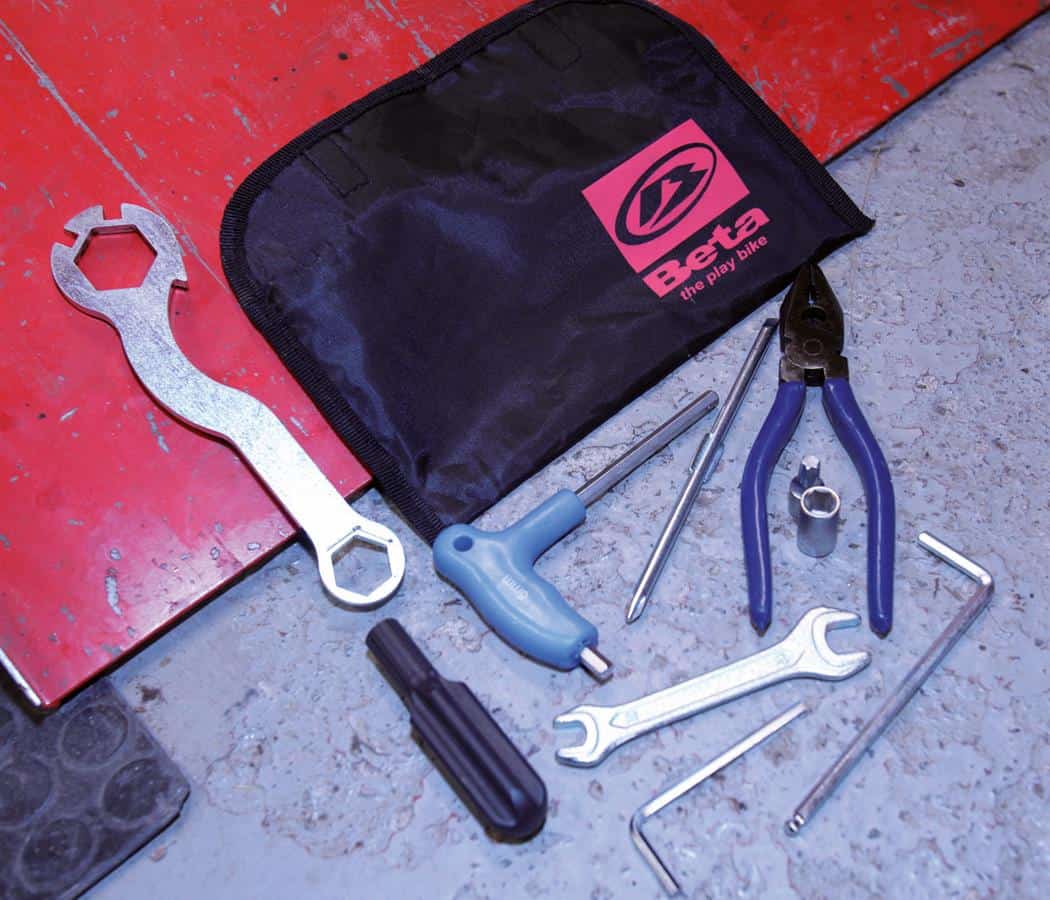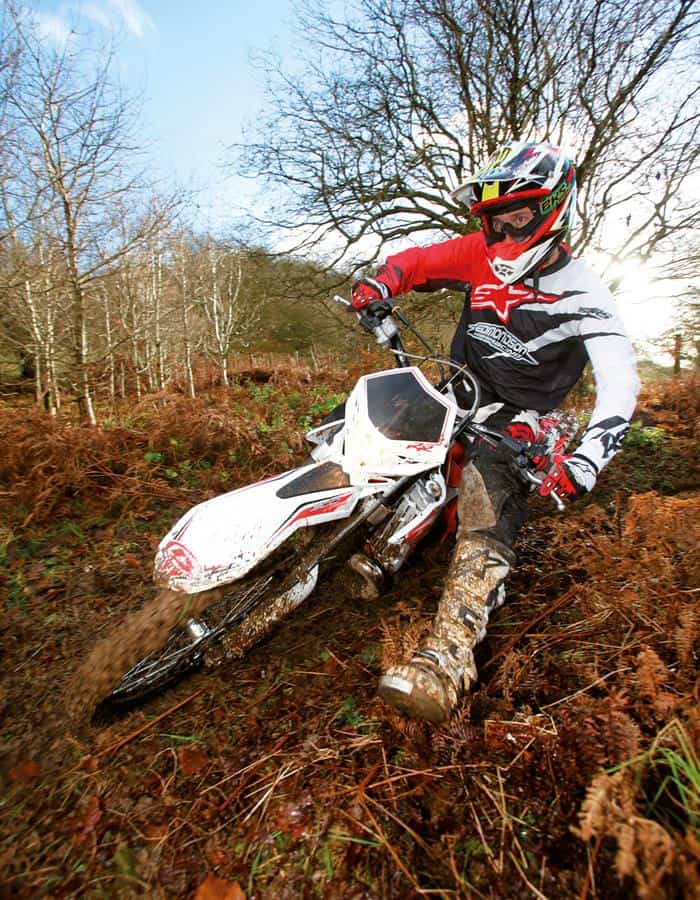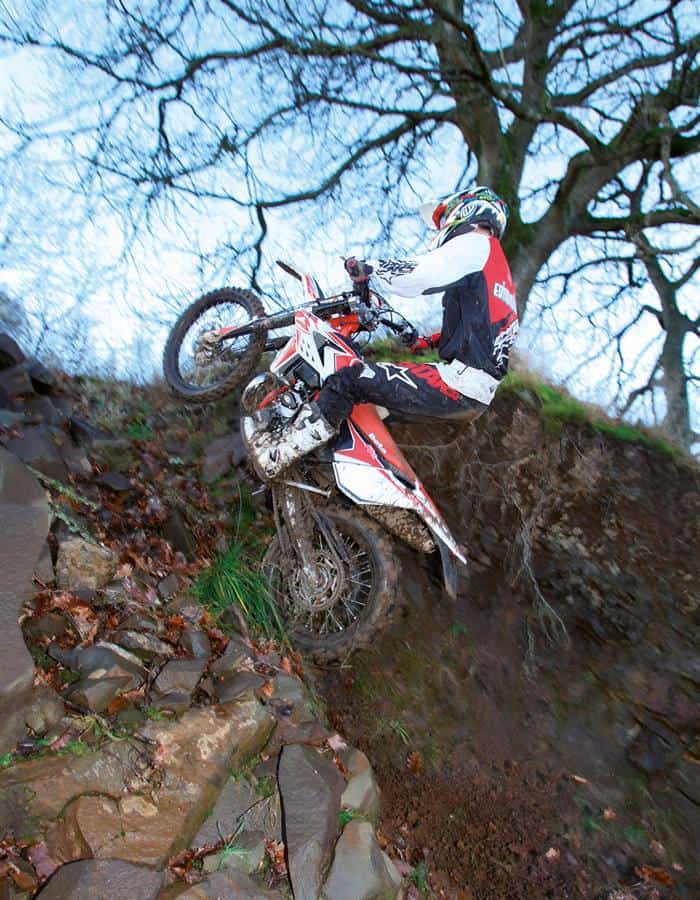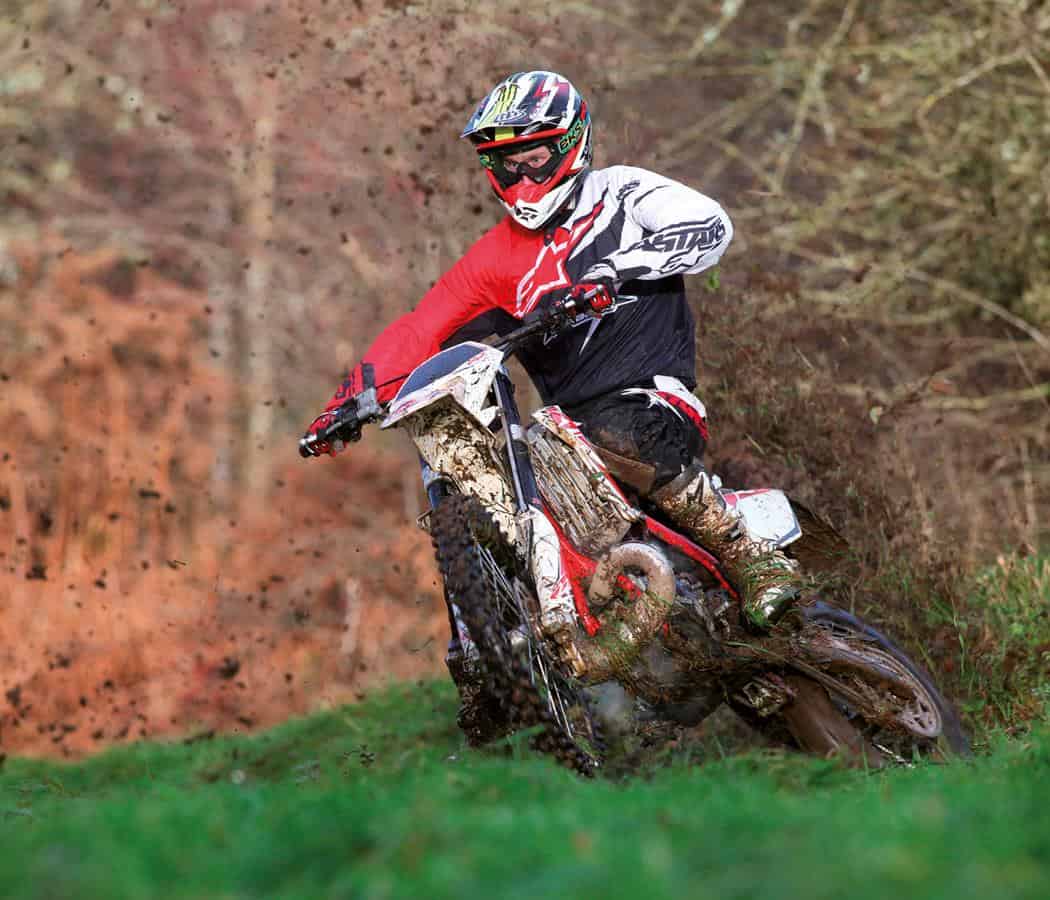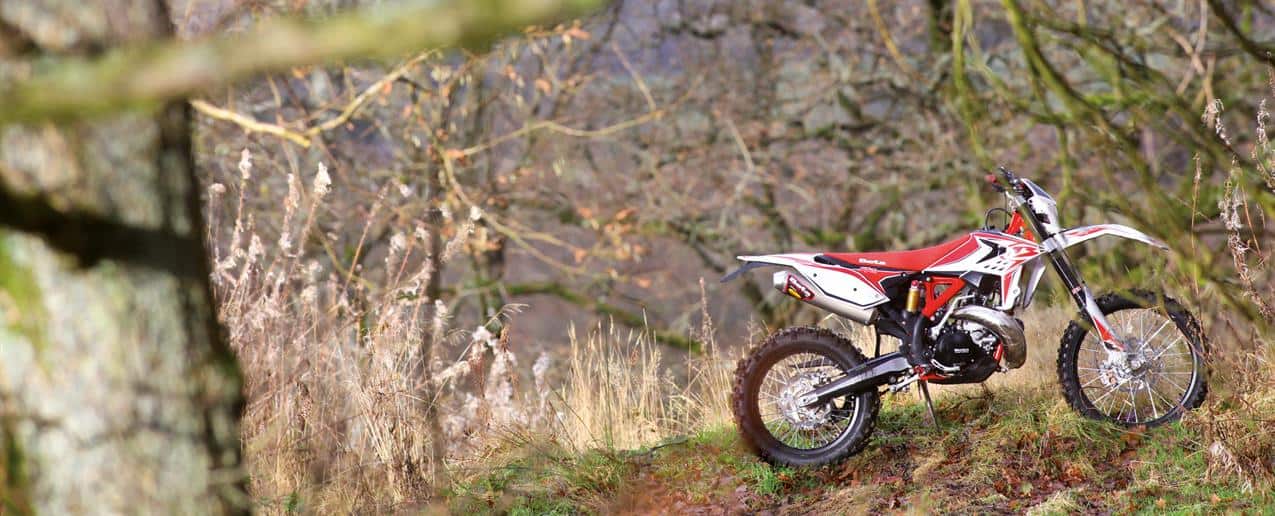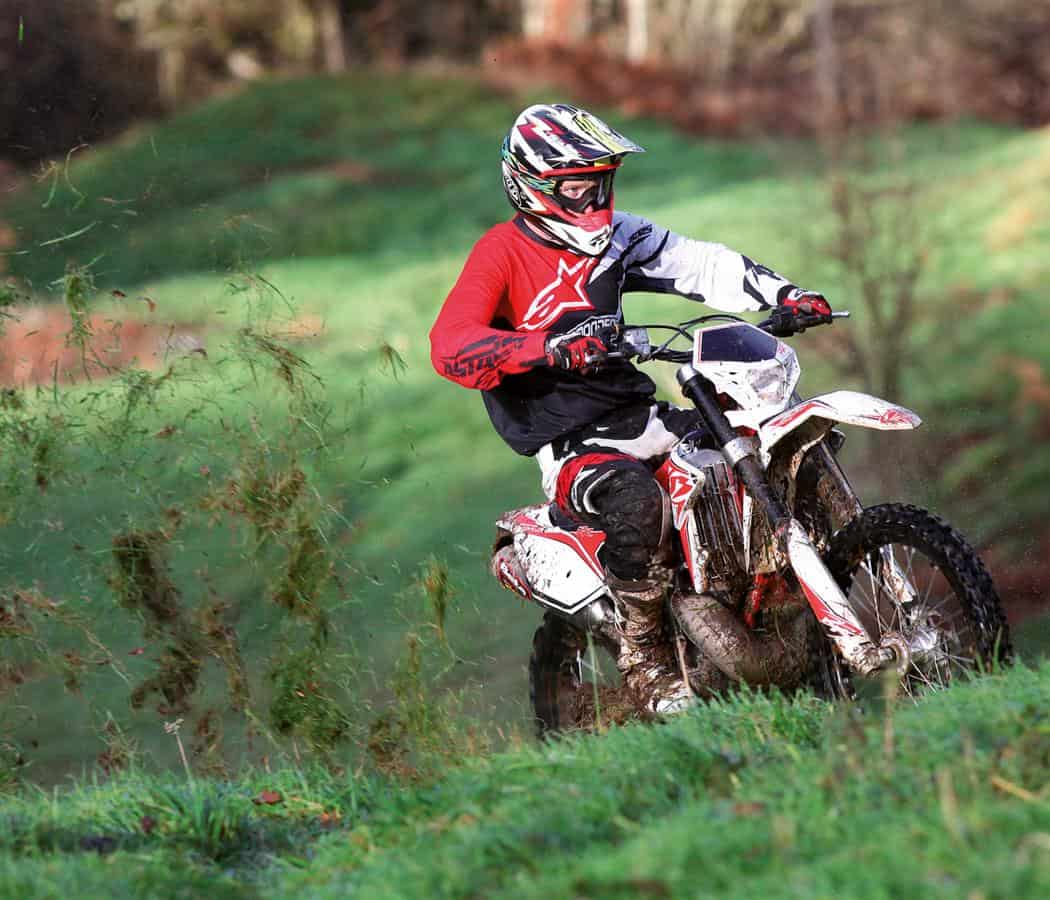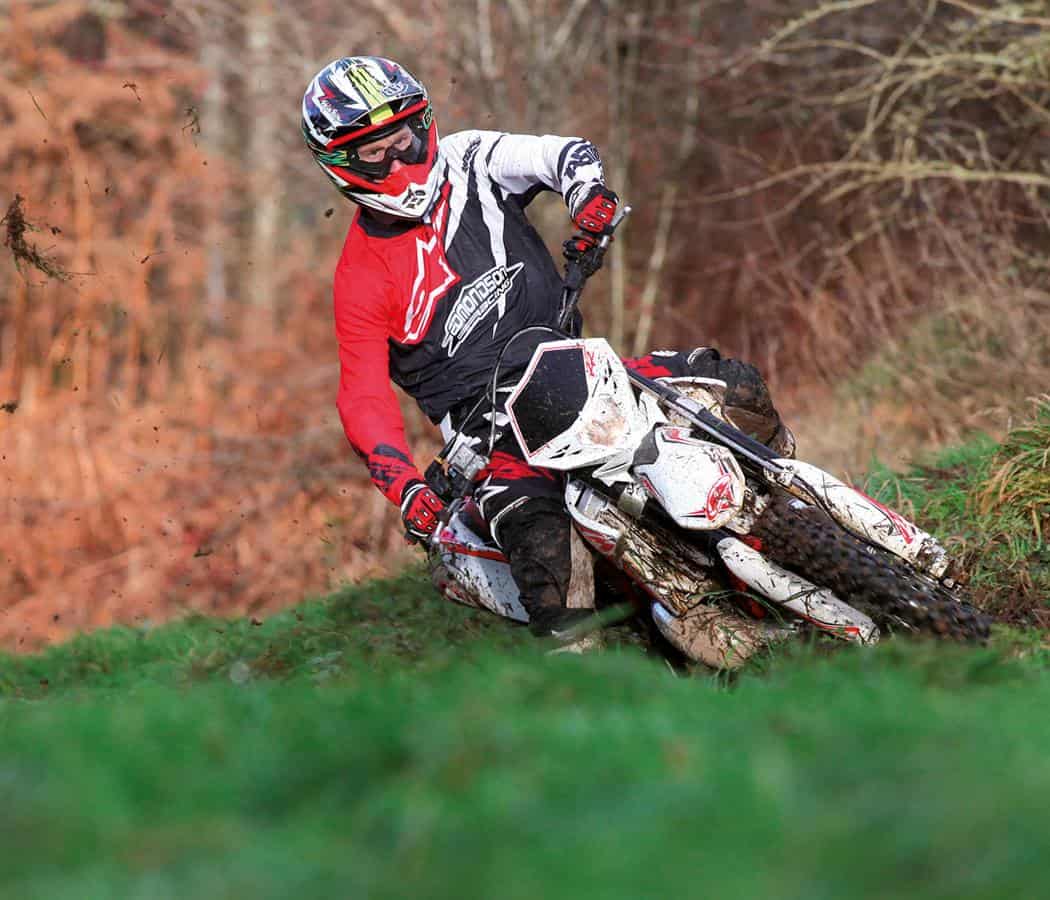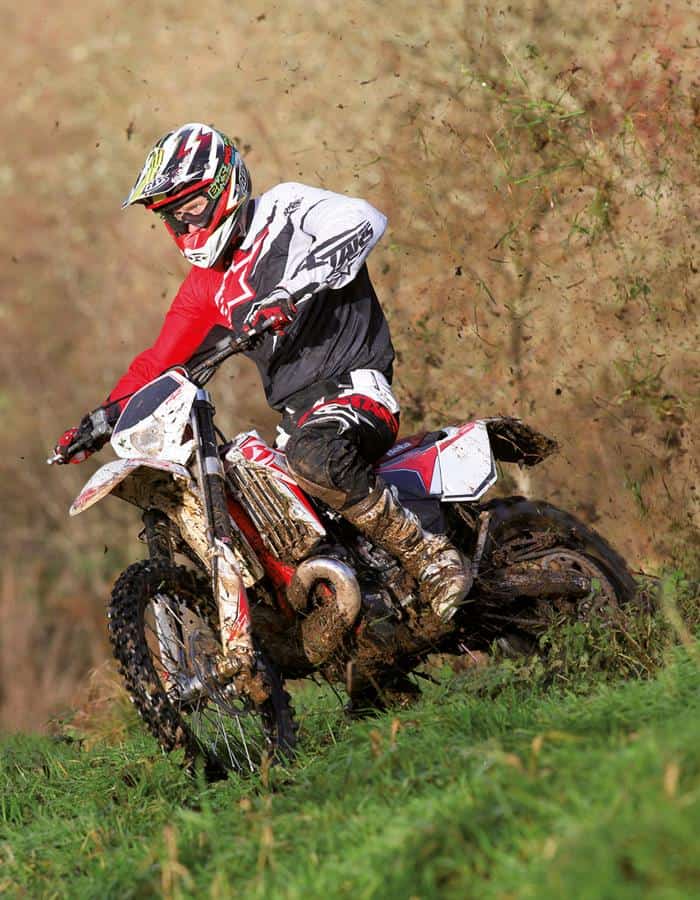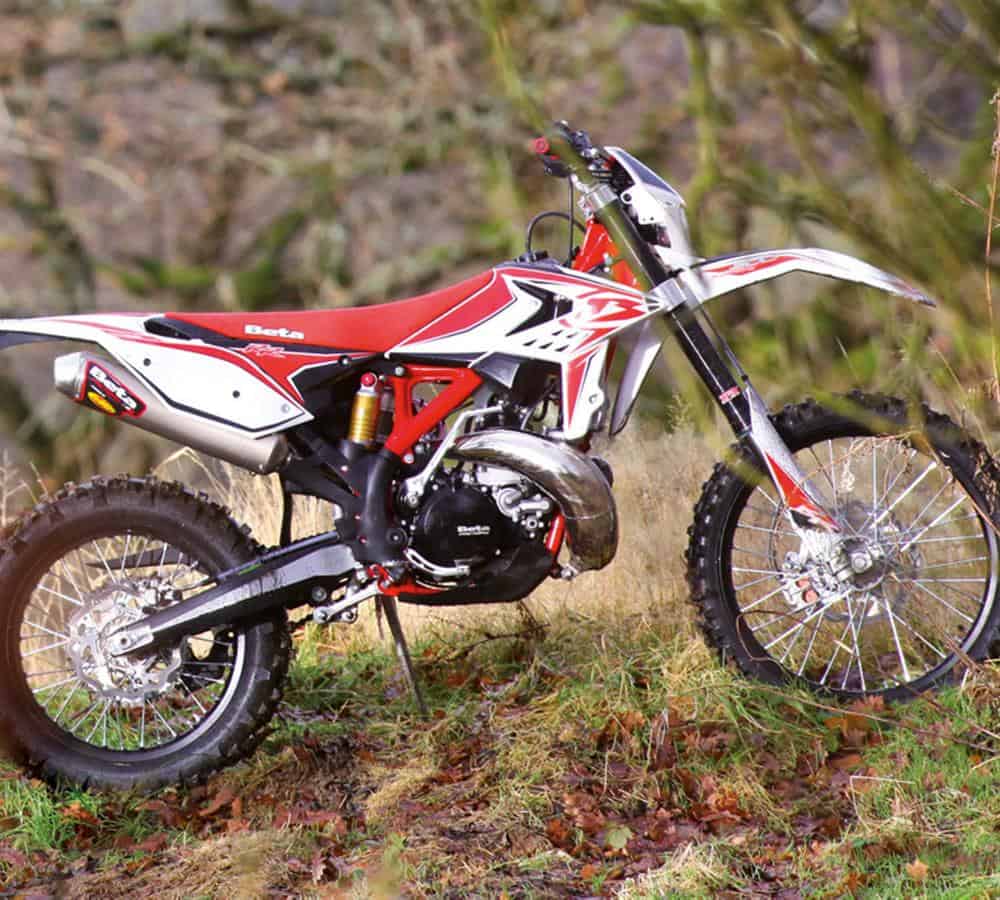RUST headed to Wales for the scoop first UK test of the all-new 2013 Beta RR300 two-stroke…
It’s easy to understand why the two-stroke has seen a resurgence in recent years. First off, the cost and complexity of rebuilding a high-revving competition four-stroke is quite at odds with the ‘home-spannered’ ethos of enduro. Though I suspect it has just as much to do with the fact that the modern-day two-stroke is incredibly easy to ride. No longer do we have to put up with all-or-nothing powerbands (WR250/300 Husky riders aside…); we’re now blessed with broad spreads of power that allow us to exploit the fact that the bikes not only weigh less than the equivalent thumper but also ‘ride light’ too. Build something that Average Joe can feel at home on and you’ll likely sell bucketloads to Average Joes the world over. Produce a bike that works for both the man in the street and elite riders too, and things look even rosier. And that’s exactly how Beta’s new RR300 feels…
Heart and Soul
With a broad range containing both two- and four-stroke triallers, some ‘true’ trailbikes, numerous learner machines, plus four-stroke enduro weapons, it seemed a natural development for the Italian brand to enter the two-stroke enduro market. Not only is it where a huge amount of interest lays right now (and therefore what little money there is floating around the dirtbike scene) but it’s not an over-saturated sector either. And although it’ll be hard to crack the orange dominance, there’s certainly room for a few more stalls in the enduro two-stroke marketplace. So they’ve launched into the most popular capacity classes, 250 and 300cc.
Beta might employ someone else’s engines for the Alp trailbikes, and their early enduro bikes were powered by KTM motors, but since 2010 they’ve been building their own enduro motors. And having developed a four-stroke in-house, and with a wealth of experience with 2T trials engines, designing an enduro two-stroke wasn’t going to be a huge issue – especially when they haven’t tried anything radical with the concept…
And that’s clever thinking, really, as without the same ‘presence’ as brands such as Husqvarna, KTM, or even Gas Gas, would people sink their money into an off-the-wall bike from a relatively small Italian brand?
Of course, you could argue that the two-stroke engine doesn’t NEED anything revolutionary doing to it (not just yet anyway, we’ll see how future legislation affects the smaller brands). They’re light, make good torque, and have excellent power characteristics for riding off-road.
And so Beta have bolted together a largely conventional powerplant, bereft of different-for-different’s-sake details. With a familiar Keihin 36mm carb, reed induction and a mechanical powervalve, it’ll be familiar to any modern 2T owner and easy to spanner using the tools in your bumbag. Or those in the bike-mounted toolkit…
Pop the seat using the push-button by the left-hand grab handle and you’ll see a small socket-headed spanner neatly mounted between the airbox and the subframe. Use it to undo the 8mm bolt which secures the left-hand sidepanel, and a small cubbyhole is revealed. Within this you’ll find a toolkit, and pretty good it is too. In the great enduro tradition, they’ve looked at rationalising what you need to carry: the spanner for the rear wheel nut also undoes the front spindle AND the spark plug. Having your tools on the bike, rather than on your person, makes for a nicer ride and if you think they’ve missed anything (shorty tyre levers if you’re running tubes) then there’s room to spare.
You don’t need any tools to access the air filter. As with modern Austrian machines, the side of the airbox pulls off to give quick ‘n’ easy access. It seals well, too, as proved by the lack of dirt found within after we’d flogged it around a small enduro loop for the afternoon…
Cold Hands, Warm Heart
With half of the country swapping their slippers for flippers as flooding hit, our mid-Wales test venue was mercifully unaffected: slippery rather than submerged – conditions were ripe for testing a two-stroke. And although sunshine gave way to showers almost as soon as we arrived, things began well for the Beta as it tipped the RUST digital scales at 111.8kg. Not quite as good as the 109.9 kilos the Italians claim, but right on the money for the 300 class, and lighter than all but the Austrian-made machines.
The Beta continues to impress as I thumb the electric start button – something no modern enduro machine, either two- or four-stroke, can afford to be without. The motor bursts into life with the first turn of the starter gear, and the same story is played out throughout the day. There’s no protracted churning, with the throttle cracked a smidgen it fires-up at the first revolution every single time. I never bother with the kicker.
This is excellent, though the location of the starter motor does concern me slightly. It’s tucked beneath the motor, snugly located within the frame rails and protected by the plastic sumpguard, so hopefully it’s not going to suffer from impact damage. However, it is likely to see an awful lot of dirt packed-in around it, and I’d want to keep all of the contacts and connections clean to keep corrosion at bay.
Anyway, it doesn’t take long for the engine to settle to an even idle, and with the choke off it revs cleanly. Time to play…
The first few hundred yards take us out of a small quarry and into the woods. Beneath the carpet of fallen leaves the mud is thick and claggy, doing its utmost to clog the tyres. I try a ‘trialsy’ approach, picking my way through, and it works until we reach a sharp turn, then a steep climb. Three-quarters of the way up I run out of grip, and talent, and the rear wheel steps-out as it meets a root. Back down and try again, though this time the route is straight up, no messin’.
Third gear, build the revs, and the tyre spins momentarily until it clears its filling of mud. Then we rocket up the hill, accompanied by a deep ‘bwoooar’ from the FMF pipe. There’s absolutely no fuss; no slithering: just effortless forward motion.
Heart Attack
After a couple of laps I know exactly where I’m going, and we tweak the motor’s adjustable powervalve. A quick twirl with an Allen key is all it takes. Until now it’s been set in the middle of its adjustment, and to really feel the difference we opt to try it in each of its extremes. But which first..?
I plump for the feistiest, and the effect is pronounced. Now the top-end comes in with a bang and there’s a real urgency to the throttle response and subsequent power delivery. The front wheel is far more inclined to head skywards on the climbs and on the way out of tree-lined corners you need to be ready for the hit of power as the motor comes onto the pipe. In these conditions, especially on such a tight course, it’s too much, too abrupt. In deep sand or on faster tracks it’ll be in its element. But not here, not now.
I fight my way around two laps, feeding the bike gears in order to soften the punch from the 293cc lump. This method works well, even if the six-speed ‘box could do with bedding-in a touch (the gearshift feels a little stiff and requires a positive boot, rather than a quick flick). The mid-range is so wonderfully strong that there’s really no need to worry about revving the bike – it’s more than happy to pull tall gears. Just as well, really…
Wind the adjuster all of the way in and it’s the polar opposite of the snappy beast I’ve just ridden. There’s still plenty of mumbo, though it’s grunt rather than hard-hitting power, and now you can crack the throttle without the need for a quick prayer first. The power curve is much flatter, making it considerably easier to eke out grip on the slippery cambers and less likely to light-up on the way out of turns. It’s much easier to ride it the tight going, but I miss the punch on the few opportunities I get to open-it-up.
So we set the powervalve adjuster back to its mid-point. And it’s lovely. Beta have dubbed their powervalve the ‘Beta Progressive Valve’ (BPV) as they claim that its actuation is, surprise surprise, progressive. I’d go with that. The delivery is incredibly linear, pulling smoothly from a gentle bottom-end into a strong, yet never overwhelming, midrange. And it’s this fantastic mid-rev power that you end up using the most.
In just the same way I did with the powervalve set to ‘stun’, short-shifting makes for fast yet unhurried progress, where you know you’re covering the ground quickly but aren’t being worn-down by an arm-stretching power delivery. Should you need that extra snap, then it’s still there – Beta have included a ‘boost chamber’ in the intake system which adds a little extra ‘charge’ to the cylinder when you give it some gas, so the throttle response is very good, great for hoiking the front-end or clearing the rear tyre. Ultimately though, the Beta isn’t endowed with a huge amount of top-end power. It’s more user-friendly than that…
There isn’t quite the low-end drive of the 300EXC either; it won’t ‘chug’ in quite the same manner. However, it will still lug itself along on very few revs. To prove this to myself I stick the bike into third and set-off to tackle the entire lap without touching the gearlever. It copes admirably, never once feeling as if it’ll stall, or even struggle for that matter. The hydraulic clutch remained ‘unslipped’…
And that leads me onto another great feature of the Beta engine – it isn’t prone to stalling. Yes, you can snuff it out by taking real liberties with your gear selection, but that’s about it. Inching down a steep snotty hill, it purrs away on idle like a contented cat. Stamp on the rear brake to slew the back-end around a turn, and it exits the other side with the motor ready and willing. In fact, it surprised me so much that I repeated the same turn over and over, getting later and later on the clutch in order to see when it would kill the motor, and it wasn’t until I essentially didn’t bother to dip the clutch that the motor stalled. Hot or cold, it idled beautifully. And that’s not something you should underestimate, especially for technical riding.
Heart Braker
The RR300’s riding position is excellent, with the kind of ‘open’ cockpit we’ve come to associate with European machines. The bars are high-ish, the gripper seat low-ish, and the seat-to-peg relationship about spot-on for someone around six foot tall. The billet clamps are also adjustable, so it shouldn’t be too hard to find a set-up to suit.
Despite only holding eight litres, the fuel tank is quite broad, with the bodywork curving out towards the ends of the rads rather than jutting-out at the last minute. You do notice this in the slower turns – it’s not incongruous just a little more portly than some of the competition.
Most of the bodywork is taken from the four-stroke models, whilst the chro-moly frame has been specially designed for the two-strokes which results in a slightly shorter wheelbase than on the thumpers. The stability remains, complemented by neutral handling. It doesn’t scythe through tight going, though nor does it push wide or feel hard to get turned. Stuff the RR into and turn and you know just what it’s going to do.
Being box-fresh, and with a largely second/third gear ultra-slippery test loop, meant it was hard to get a feel for what they’d be like with a few hours on them, so I’ll reserve judgement except to say that thankfully, they didn’t seem anywhere near as bad as some Sachs units we’ve tried in recent years. Their action was much more supple. Tool-less rebound adjustment is a nice touch, mind you.
A soft feeling to the Sachs shock made it easy to feel for grip from the rear tyre, though again it’ll take some more diverse terrain to really get a feel for it. Those few dug-out holes, small rocks and awkward roots found around the incredibly slippery lap did little to upset the back-end, and it landed the occasional jump without issue. Mid you, the only sections of the lap where we hit any kind of speed had little to trouble modern dirtbike suspension and it was more of an issue getting the bike slowed on the slick surface…
Just as well then, that the brakes are absolutely first rate. Nissin front and rear, with a 260mm wave disc upfront, even on off-camber wet grass or a slippery mud descent you could feel exactly how much pressure to apply before the tyre began to slide. And on the grippier surface of a metalled access track there was plenty of stopping power to haul the bike down from a fifth gear blast to walking pace in just a few yards. Yep, the RR’s brakes are up there amongst the best.
Heart of the Country
Although the RR300 is fully road homologated (it’ll doubtless arrive from the dealer in enduro spec, tho’) our bike hadn’t yet been registered so we can only speculate at what it’d be like on the trail. And ‘not bad’ would be my guess. It’s not overly vibey and the smooth power delivery and stable chassis should make for a relaxed ride, even if the seat’s probably a trifle firm for epic all-dayers. Whether it’ll annoyingly ‘hunt’ on a part throttle, like the KTM/Berg does, I can’t say – let’s hope not. The clocks are neat and nicely slimline, and if you’re over six foot you’ll find that the grab handles are quite effective. Shorties might wish they were located a bit lower, tho’.
The sidestand is slightly less impressive, so it’s probably best if you shirk your gate-opening responsibilities or keep your eyes peeled for a handy tree/fence/wall/cow to lean the bike against. Fortunately it’s not a flip-up device, it’s just a little too pointy to be of much use on a squidgy British trail. Oh, and some handguards as standard would be nice…
While I’m having a bit of a whinge, the overall build quality (which seems very good) is let down by a couple of details such as the way that the two rad panels cover the top of the tank and meet between the filler cap and the seat. It just isn’t particularly neat and cheapens the look a little – not an issue that affects the way the bike works, or its robustness, but I noticed it every time I hopped onboard. Factory-fitted frameguards go some way to redressing the matter.
Heart of the Matter
There’s an awful lot to like about Beta’s new RR300, most of which stems from the way that the engine delivers its power. It’s so incredibly linear; so predictable; and so unhurried that it fills you with confidence within the first few hundred yards. There’s just no need to have the engine working hard, instead ride along on the midrange and you still maintain a decent pace. It really flatters a smooth approach.
The easy-adjust powervalve might not be a new idea, but is a fantastic feature, and makes changing the power characteristics to suit the conditions a doddle. I can’t wait for a manufacturer to give us this facility from the handlebars, or even fit an on-the-fly adjuster to the side of the motor in a similar style to the aftermarket ‘Provini’ adjuster! For the meantime, we’ll have to put up with getting the tools out, but the rewards are worth it.
The Beta RR300 doesn’t rewrite the E3 two-stroke rulebook. It isn’t a revelation. What it is is a very good example of the breed – a real alternative to its established rivals – and one which has broad appeal. With UK buyers cautious about investing in their four-stroke models, Beta isn’t a big name on our enduro scene right now. But joining the 2T Brigade has the potential to change that. Especially if the bikes are all as good as this one…
Beta RR300
Engine: Dual start, reed valve, two-stroke
Displacement: 293.1cc
Bore & stroke: 72 x 72mm
Transmission: 6-speed
Frame: Chro-moly double cradle
Front susp: 48mm USD Sachs fork, fully adj
Rear susp: Sachs shock, fully adj
Front brake: 260mm disc, Nissin two-piston caliper
Wheelbase: 1482mm
Seat height: 930mm (claimed)
Fuel capacity: 8L
Weight: 111.8kg (wet, tested)
Contact: Beta UK on 01535 655970 www.beta-uk.com

